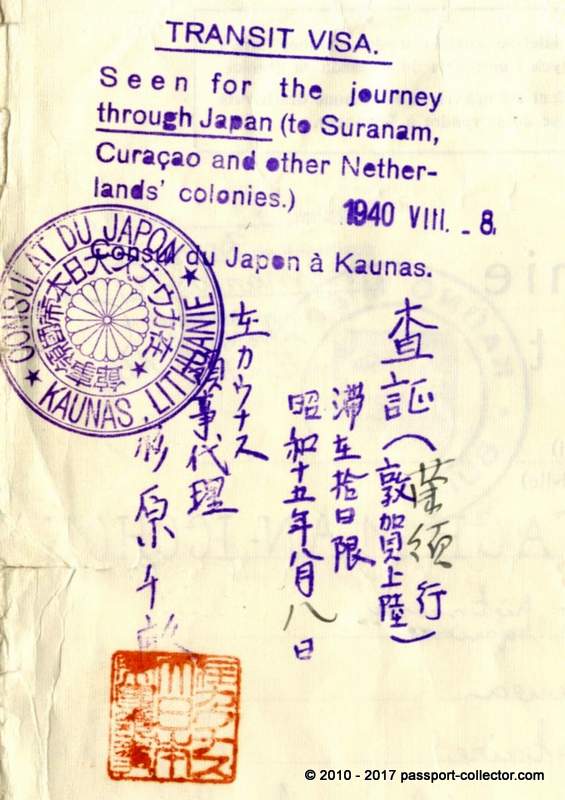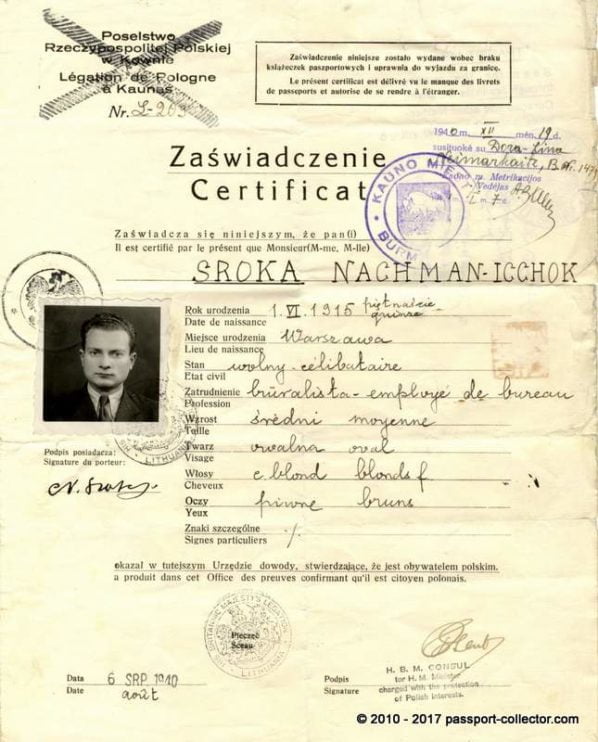Jewish Travel Document SUGIHARA
Jewish Travel Document SUGIHARA
THIS SINGLE PAPER ALLOWED THE JEWISH BEARER TO ESCAPE AN OTHERWISE CERTAIN DEATH IN LITHUANIA
A transit visa from Kovno to Curacao via Japan, issued by the Righteous Among the Nations Sempo Sugihara just before the annihilation of Lithuanian Jewry, to save the life of Nachman Yitzchak Sroka, who escaped from Warsaw to Lithuania at the outbreak of the war.
A rare historical item. Kovno, Lithuania, August 1940. Double paper leaf. 23×29 cm, written on both sides. Certificate of Polish citizenship of Nachman Icchok Sroka, which the British Consulate and the British Office for Polish Interests in Kovno, Lithuania, issued.
A photograph of Sroka with Polish and British stamps and personal details was filled out by hand. On the second page, a transit visa to Curacao via Japan from the date 8.8.40, written and stamped in English and Japanese by the Japanese Consul Sempo Sugihara.

This a rare and important historical document
a testimony to the noble deeds of the diplomat Sempo Sugihara who did all he could to save Jews in Lithuania’s crucial moments of the summer of 1940. The actions of Sugihara, who acted against orders, were later recognized throughout the world as an act of tremendous bravery and humaneness, and he was awarded a medal as one of the Righteous Among the Nations.
With the German invasion of Poland at the outbreak of World War II, many Polish Jews escaped to the Baltic countries. In the summer of 1940, when Russia forcibly annexed Lithuania, the refugees tried to escape from Europe by every possible means. The world’s gates were locked, and it was impossible to pass through the Soviet Union without a valid visa for the final destination.
After Jan Zwartendjik, the temporary Dutch Consul in Lithuania, agreed to issue visas to the Dutch Curacao Island; the Russians agreed that the refugees could pass through the Soviet Union on their way to Curacao on the condition that they receive transit visas. Therefore, Dr. Zerach Warhaftig, one of the leaders of the Mizrachi movement, approached the Japanese Consul, Sempo Sugihara, and asked him to issue the visas. Jewish Travel Document SUGIHARA
Chiune “Sempo” Sugihara (1900-1986) served as the Deputy Consul of the Japanese Empire in Lithuania in Kovno and the acting Consul in the critical window of opportunity of the summer of 1940. Despite his government’s refusal of the offer, Sugihara decided to act and issue the permits to the many Jewish refugees who flooded the Consulate’s doors. In the remaining weeks, before he left Kovno, he worked tirelessly, for over 18 hours a day, to issue these visas, knowing that they would save the lives of their bearers.
Many yeshiva students, such as the students of the Mir Yeshiva who had also escaped to Lithuania, took advantage of this opportunity to flee. During August 1940, when the Russians took control of Lithuania, Sugihara and Zwartendjik were forced to stop their activities. Even as he boarded the train, Sugihara continued stamping passports, knowing that each was a lifesaver for its recipient. Jewish Travel Document SUGIHARA

There is a list of 2,139 names in the official Sugihara database, and Nachman Sroka’s name appears in row 1,500. His name is displayed in “The Flight and Rescue” exhibition in the United States Holocaust Memorial Museum in Washington. Jewish Travel Document SUGIHARA
FAQ Passport History
Passport collection, passport renewal, old passports for sale, vintage passport, emergency passport renewal, same day passport, passport application, pasaporte passeport паспорт 护照 パスポート جواز سفر पासपोर्ट
1. What are the earliest known examples of passports, and how have they evolved?
The word "passport" came up only in the mid 15th Century. Before that, such documents were safe conducts, recommendations or protection letters. On a practical aspect, the earliest passport I have seen was from the mid 16th Century. Read more...
2. Are there any notable historical figures or personalities whose passports are highly sought after by collectors?
Every collector is doing well to define his collection focus, and yes, there are collectors looking for Celebrity passports and travel documents of historical figures like Winston Churchill, Brothers Grimm, Johann Wolfgang von Goethe. Read more...
3. How did passport designs and security features change throughout different periods in history, and what impact did these changes have on forgery prevention?
"Passports" before the 18th Century had a pure functional character. Security features were, in the best case, a watermark and a wax seal. Forgery, back then, was not an issue like it is nowadays. Only from the 1980s on, security features became a thing. A state-of-the-art passport nowadays has dozens of security features - visible and invisible. Some are known only by the security document printer itself. Read more...
4. What are some of the rarest and most valuable historical passports that have ever been sold or auctioned?
Lou Gehrig, Victor Tsoi, Marilyn Monroe, James Joyce, and Albert Einstein when it comes to the most expensive ones. Read more...
5. How do diplomatic passports differ from regular passports, and what makes them significant to collectors?
Such documents were often held by officials in high ranks, like ambassadors, consuls or special envoys. Furthermore, these travel documents are often frequently traveled. Hence, they hold a tapestry of stamps or visas. Partly from unusual places.
6. Can you provide insights into the stories behind specific historical passports that offer unique insights into past travel and migration trends?
A passport tells the story of its bearer and these stories can be everything - surprising, sad, vivid. Isabella Bird and her travels (1831-1904) or Mary Kingsley, a fearless Lady explorer.
7. What role did passports play during significant historical events, such as wartime travel restrictions or international treaties?
During war, a passport could have been a matter of life or death. Especially, when we are looking into WWII and the Holocaust. And yes, during that time, passports and similar documents were often forged to escape and save lives. Example...
8. How has the emergence of digital passports and biometric identification impacted the world of passport collecting?
Current modern passports having now often a sparkling, flashy design. This has mainly two reasons. 1. Improved security and 2. Displaying a countries' heritage, icons, and important figures or achievements. I can fully understand that those modern documents are wanted, especially by younger collectors.
9. Are there any specialized collections of passports, such as those from a specific country, era, or distinguished individuals?
Yes, the University of Western Sidney Library has e.g. a passport collection of the former prime minister Hon Edward Gough Whitlam and his wife Margaret. They are all diplomatic passports and I had the pleasure to apprise them. I hold e.g. a collection of almost all types of the German Empire passports (only 2 types are still missing). Also, my East German passport collection is quite extensive with pretty rare passport types.
10. Where can passport collectors find reliable resources and reputable sellers to expand their collection and learn more about passport history?
A good start is eBay, Delcampe, flea markets, garage or estate sales. The more significant travel documents you probably find at the classic auction houses. Sometimes I also offer documents from my archive/collection. See offers... As you are already here, you surely found a great source on the topic 😉
Other great sources are: Scottish Passports, The Nansen passport, The secret lives of diplomatic couriers
11. Is vintage passport collecting legal? What are the regulations and considerations collectors should know when acquiring historical passports?
First, it's important to stress that each country has its own laws when it comes to passports. Collecting old vintage passports for historical or educational reasons is safe and legal, or at least tolerated. More details on the legal aspects are here...
Does this article spark your curiosity about passport collecting and the history of passports? With this valuable information, you have a good basis to start your own passport collection.
Question? Contact me...

